There are some things we can do now to help bats.Some are as simple as putting up a bat house.
Bat Houses Buy a bat house or kit. Build it yourself. Find free plans online.
Bat Habitat Bats need more than a roost. They need a place to forage for insects or nectar. They also need fields, forests, marshes and chaparral.They need water. Permanent wet areas are critical for bats. You can find a local group working to save habitat in your area.
Adopt a bat Bat Conservation International has several programs to support bats. They sponsor conservation and save thousands of bats a year.
Don't trim your palm trees At least two species roost under dead palm fronds, the western yellow bat and the big brown bat. Cosmetic trimming is one of the biggest threats to the Western yellow bat. Not only does trimming eliminate potential roosting places, but if done during the months of May through September, it may actually injure the babies. Birds like the orioles also nest in palm fronds. You can put up a predator guard around the tree to protect the bat pups and bird chicks.
Keep cats indoors Domestic cats are not a natural predator in the Western Hemisphere but were brought over by settlers.There are an estimated 60 million cats kept as pets in the US. If each cat kills only one bird a year that would come to 60 million birds every year. That would account for more bird deaths than any oil spill. Scientific studies actually show that cats kill hundreds of millions of migratory songbirds and small mammals, including bats each year.
Prevent Drownings Bats must drink water. They can loose up to 30% of their body weight by evaporation in a night. Often, birds as well as bats, drown in pools and livestock tanks. They could survive if there was a way they could get out of the water. I've often floated a board in my animals' water tanks to keep small animals from drowning. Here's another nifty solution, below, the Froglog.To provide save water for bats, visit Water for Wildlife.





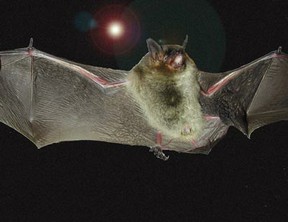 America, eat insects. A single brown ba can consume between 3,000 to 7,000 mosquitoes in a single night.They reduce the mosquito population and therefore the incidences of diseases that they carry. Diseases like West Nile Virus would be more prevalent without the aid of the bat.
America, eat insects. A single brown ba can consume between 3,000 to 7,000 mosquitoes in a single night.They reduce the mosquito population and therefore the incidences of diseases that they carry. Diseases like West Nile Virus would be more prevalent without the aid of the bat.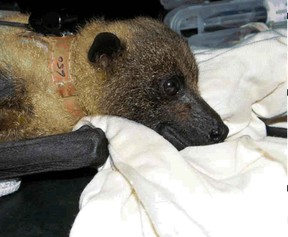 Many people have learned about bats recently with the media news about the White Nose Syndrome (WNS) that is killing so many bats. WNS is a fungus that attacks the muzzle, nose and ears and is spread from bat to bat The fungus somehow causes the animal to wake up during its winter hibernation.Consequently the bat starves or freezes to death after using up its stored winter fat. It is responsible for millions of bat deaths over the past several years.
Many people have learned about bats recently with the media news about the White Nose Syndrome (WNS) that is killing so many bats. WNS is a fungus that attacks the muzzle, nose and ears and is spread from bat to bat The fungus somehow causes the animal to wake up during its winter hibernation.Consequently the bat starves or freezes to death after using up its stored winter fat. It is responsible for millions of bat deaths over the past several years.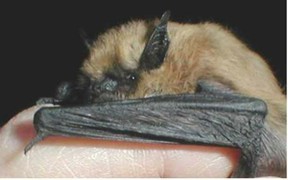 What some people may not know is the deaths caused by wind turbines. I always thought wind turbines were a good idea, a green energy source. I am mesmerized by their size and stately figure as the huge blades rotate.
What some people may not know is the deaths caused by wind turbines. I always thought wind turbines were a good idea, a green energy source. I am mesmerized by their size and stately figure as the huge blades rotate.






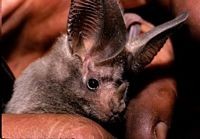

 How I Found My Free Family History Programon 09/05/2013
How I Found My Free Family History Programon 09/05/2013
 Finding a Graveon 09/01/2013
Finding a Graveon 09/01/2013
 Do Border Collies Make Good Pets?on 08/11/2013
Do Border Collies Make Good Pets?on 08/11/2013
 Hubert Patey - an Indentured Servanton 08/02/2013
Hubert Patey - an Indentured Servanton 08/02/2013


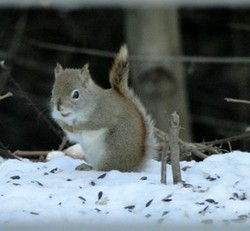
Batty and Not-so-batty Comments
And not just mosquitoes. They do an amazing job of keeping the insect population down.
Bats really are interesting creatures. Without them we'd be overrun with mosquitoes.
Thanks for the compliment. I've never feared bats either, but didn't know too much about them. I love researching things like this.
This is a wonderful article. Thanks for writing it. I have never feared bats and like to see them soaring around at night.
Thanks. Yes, I was shocked too. Even when we think we are doing a good thing, there are repercussions that we don't think about.
I'd put out water, but I'm right on the lake. They can probably get plenty there.
Aw the poor bats, they are so beneficial to us humans. I do hope the bat advocates save them. :)K